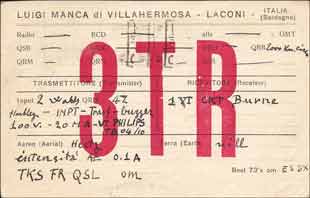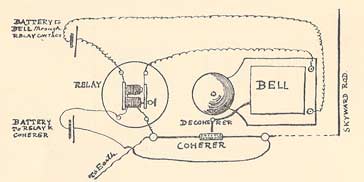Amateur Radio History: Ham Radio History
The history of amateur radio or ham radio is a fascinating story that tells of amateur experimenters pitting their wits many technical issues and coming up with results despite the lack of funds.
Ham Radio History Includes:
Ham radio history overview
Early foundations
First radio hams
Early ham radio equipment
Licenses introduced
Callsigns
National societies
First World War
Trans-Atlantic contacts
The history of amateur radio has its beginnings in the very foundations of radio or wireless technology itself.
When radio technology started to appear there was often no distinction between professional and amateur. As radio or wireless as it was called was often thought of as only an interesting phenomenon for which there was little use, many professional scientists and engineers did not exploit it as they might (although some did) and this left open wide the field for amateur experimenters.

Ham radio history
Ham radio has been in existence for over a hundred years. In fact ever since radio technology itself has been existence, amateur experimenters have wanted to use and investigate radio technology.
The history of amateur radio is a fascinating story of individuals and groups of radio hams experimenting and sometimes succeeding against all the odds.
Although in many instances professionals lead the way, there are a few notable exceptions where radio amateurs discovered new aspects of radio technology and in others they opened up the way as professional thinking was quite different.
All of these aspects make the history of amateur radio a fascinating story and one which shows how radio hams paved the way for radio technology in many areas.
The history of amateur radio can be split into a number of different stages, each of which tells the story of a different aspect of ham radio history.
- Early beginnings: The history of amateur radio has its roots in the first experiments that were undertaken. Although famous names like James Clerk Maxwell whose equations defined electromagnetic waves in terms of mathematics, and Heinrich Hertz who is credited with being the first person to recognise light and also the lower frequency signals in the radio spectrum were all the same electromagnetic waves defined by Maxwell. However it was people like Marconi who pushed these early ideas forwards. Although Marconi did not invent radio as many believe, he actually saw the benefits of it and as an amateur experimenter he pushed forwards the boundaries of what could be done turning his amateur experiments into professional endeavours.
Read more about . . . . early foundations of amateur radio history.
- First radio amateurs: In any history it is often difficult to identify the first person to achieve something as many are knocking on the door of a discovery at the same time. The same is probably true of the first radio amateur, especially as the term radio amateur would not have been defined then as it is now.
Read more about . . . . first radio hams.
- Early ham radio equipment: Early ham radio transmitters were very crude as were the receivers. The earliest transmitters consisted of spark transmitters and these continued to be used for many years. It was only in the 1920s with the cost of valves / tubes coming down that spark transmitters stopped being used. In the early days, distances of just a few miles could be achieved, but eventually the distances rose. Also the receivers were very simple by today's standards - even crystal sets were deemed to be state of the art.

Circuit of a coherer radio receiver Read more about . . . . pre-1414 early ham radio equipment.
- Licenses: In the early days in the history of ham radio it was not envisaged quite how radio would develop. Anyone was allowed to transmit and there was no regulation. However as radio started to be used for commercial uses it was agreed that licensing would be required. In the UK licenses started to be issued in 1904, and this occurred around the same time in many other countries. Callsigns also started to be issued, but this occurred a little later.
Read more about . . . . first ham radio licenses were introduced.
- Callsigns: Initially when amateur radio stations went on the air, no callsigns existed. It soon became clear that some form of identification was needed. In some countries radio amateurs started inventing their own, but soon callsigns were issued by the authorities.
Read more about . . . . first amateur radio callsigns.
- National societies formed: With the interest in amateur radio growing, another major milestone in the history of amateur radio occurred as people naturally met together to discuss their common interest. As a result local and then national societies formed. The first national society appeared to be the Wireless Institute of Australia which was formed in when 50 people came together, in March 1910, to form an organisation to promote the use of wireless. Another society, the Radio Society of Great Britain can trace its origins back to the formation of the London Wireless Club which was inaugurated in West Hampstead on 5 July 1913. Then the USA, the ARRL was founded on 6 April 1914 by Hiram Percy Maxim of Hartford, Connecticut. Other societies around the globe were also formed, enabling members to exchange information and encourage each other to build equipment and contact each other.
Read more about . . . . first national amateur radio societies.
- First World War : For the duration of the First World War amateur radio activities were suspended in most countries. This occurred in 1914 in most of Europe including the UK, and then when the USA joined the battle activities were stopped there. Nevertheless those interested in radio found their skills used for the war efforts.
- Spanning the Atlantic: During the 1920s the distances over which contacts could be made increased and as a result the possibility of making trans-Atlantic and even trans-globe contacts became a real possibility. Tests were organised to see whether transmissions could be made across the Atlantic on Short Waves and soon contacts were being made. Contacts were even made around the globe.
Read more about . . . . first trans-Atlantic contacts.
- International callsigns: With the distances over which contacts started to be made in the 1920s, contacts were being made between stations in different countries. As a result it became necessary to provide a means of identifying the countries from which stations were operating, and also preventing the duplication of callsigns that could occur.
- Second World War: As with the First World War, amateur radio operations were ceased in most countries involved in the conflict for its duration. However some operations did take place from Germany and its associated countries, although this was on a very limited basis.
As the years passed, the history of amateur radio showed that technology developed and new techniques were used. However the same pioneering spirit of some of the early radio amateurs was retained, with many radio hams contributing to the development of technology in many ways.
 Written by Ian Poole .
Written by Ian Poole .
Experienced electronics engineer and author.
More History:
Radio history timeline
History of the radio
Ham radio history
Coherer
Crystal radio
Magnetic detector
Spark transmitter
Morse telegraph
Valve / tube history
PN junction diode invention
Transistor
Integrated circuit
Quartz crystals
Classic radios
Mobile telecoms history
Vintage mobile phones
Return to History menu . . .



